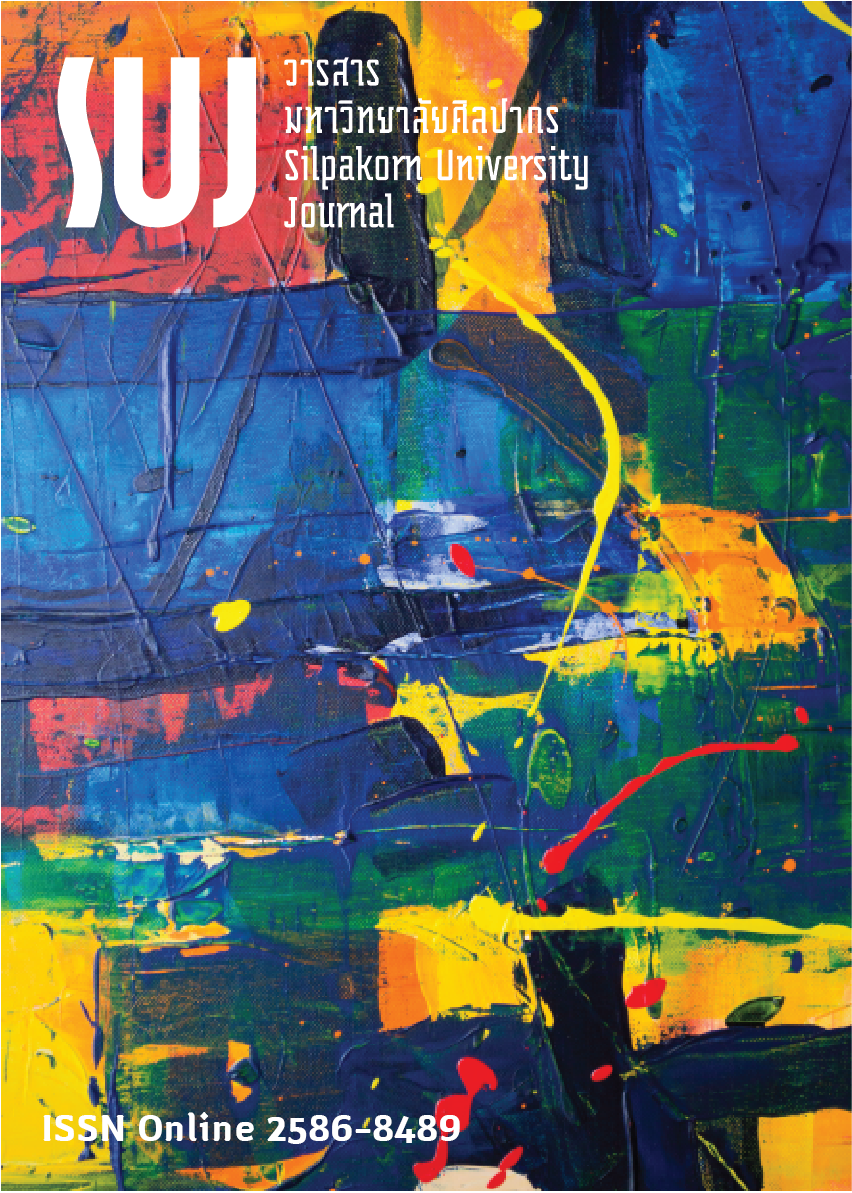ความรู้ในตราสินค้าที่มีผลต่อความผูกพันของลูกค้าในตราสินค้าไวน์ผลไม้ไทยระดับพรีเมี่ยม (Brand knowledge affecting customer- Thai premium fruit wine brand engagement)
Main Article Content
Abstract
วัตถุประสงค์ของการวิจัย เพื่อศึกษาความสัมพันธ์ระหว่าง ความรู้ในตราสินค้าไวน์ผลไม้ระดับพรีเมี่ยม กับความผูกพันของลูกค้าในตราสินค้า โดยรวบรวมข้อมูลด้วยแบบสอบถามมาตราส่วนประมาณค่า 5 ระดับตามแนวของไลเคิร์ท จำนวน 6 องค์ประกอบ รวม 40 ข้อ จากกลุ่มตัวอย่างที่เป็นลูกค้าตราสินค้าดรีมมี แวลลีย์ จำนวน 385 ราย ผู้ตอบแบบสอบถามส่วนใหญ่เป็น เพศหญิงมีอายุ 21 ถึง 40ปี มีสถานภาพสมรสจำนวนมากที่สุด อาศัยอยู่ในภาคเหนือ ระดับการศึกษาปริญญาตรี ประกอบธุรกิจส่วนตัวจำนวนมากที่สุด และส่วนใหญ่มีรายได้โดยเฉลี่ยต่อเดือนต่ำกว่า 50,000บาท ส่วนใหญ่เป็นลูกค้า ตราสินค้าดรีมมี แวลลีย์มาแล้วไม่ต่ำกว่า 1 ปี ส่วนใหญ่ดื่มไวน์ เดือนละครั้งหรือมากกว่า เหตุผลในการดื่มไวน์ คือเพื่อสุขภาพและการผ่อนคลาย สถิติที่ใช้ในการวิเคราะห์ข้อมูล ได้แก่ การวิเคราะห์การถดถอยเชิงพหุคูณ (multiple regression analysis) ผลการวิจัย พบว่า องค์ประกอบความรู้ในตราสินค้า (brand knowledge) โดยรวมอยู่ในระดับรู้จัก และองค์ประกอบทุกด้านของความรู้ในตราสินค้าอยู่ในระดับมาก เรียงลำดับ คือ การรับรู้ในองค์ประกอบความรู้ในตราสินค้าด้านคุณสมบัติที่เกี่ยวกับตัวสินค้า(product related attributes) ด้านประโยชน์เชิงหน้าที่ของตราสินค้า (functional benefits) ด้านทัศนคติที่มีต่อตราสินค้า (attitudes) ด้านประโยชน์เชิงสัญลักษณ์ (symbolic benefits) ด้านคุณสมบัติที่ไม่เกี่ยวกับตัวสินค้า (non-product related attributes) และด้านประโยชน์เชิงประสบการณ์ (experiential benefits) ส่วนความผูกพันของลูกค้าในตราสินค้า (customer-brand engagement) อยู่ในระดับผูกพัน การทดสอบความสัมพันธ์เชิงเส้นขององค์ประกอบความรู้ในตราสินค้ากับความผูกพันที่มีต่อตราสินค้า ที่ระดับความเชื่อมั่นร้อยละ 95 พบว่าองค์ประกอบด้านทัศนคติต่อตราสินค้า มีผลมากที่สุด รองลงมาคือ องค์ประกอบด้านประโยชน์เชิงประสบการณ์ องค์ประกอบด้านคุณสมบัติที่ไม่เกี่ยวกับตัวสินค้าและองค์ประกอบด้านการรู้จักตราสินค้า เมื่อทดสอบตามกลุ่มอายุและเหตุผลของการดื่มไวน์ผลไม้ของลูกค้า พบว่าองค์ประกอบความรู้ในตราสินค้าที่มีผลต่อความผูกพันในตราสินค้า มีความแตกต่างกันบางประการ
The objective of research was to investigate the relationship between the premium fruit wine brand knowledge and customer–brand engagement. Data was collected by anonymous questionnaire survey of forty items of five-point Likert scale encompassing six brand knowledge dimensions. Respondents were 385 customers of Dreamy Valley brand. The majority of the respondents were female aged between 21 and 40 years old. The majority of respondents were married. They mostly lived in the North and held bachelor’s degree. Also they were self-employed with monthly income lower than 50,000 Baht. Most of them had been the customers of Dreamy Valley brand for at least one year. They drank wine once a month or more for the purpose of health and relaxation. Data was analyzed, using Multiple Regression Analysis. The results showed that brand awareness was at the level of recognition and every brand knowledge dimension including product related attributes, functional benefits, brand attitudes, symbolic benefits, non-product related attributes, experiential benefits by perception was at a high level in descending order. The customer-brand engagement was at the engaged level. It was found that the dimensions affecting the customer–brand engagement were 4 dimensions: brand attitude, experiential benefits, non-product attributes, and brand awareness with a confidence level of 95 percent. Regarding brand knowledge affecting customer-brand engagement, there were differences among different age groups and purposes of wine drinking.
Downloads
Article Details
References
Aaker, David A. (1991). Managing Brand Equity: Capitalizing on the Value of a Brand Name. New York: The Free Press.
Aaker, David A. and Alexander L. Biel. (1993). Brand Equity and Advertising: An Overview, in Brand Equity and Advertising: Advertising’s Role in Building Strong Brands, David A. Aaker and Alexander L. Biel, eds. Hillsdale, NJ: Lawrence Erlbaum Associates.
Abdullah, & Siraj, Sadaf. (2016). Brand Equity through Customer Engagement in Social Media: A Critical Review. IOSR Journal of Business and Management, 18: 38-46.
Biel, A. L. (1992). How Brand Image Drives Brand Equity. Journal of Advertising Research, (11): 6-12.
Brodie, R. J., Hollebeek, L. D., Juric, B., & Ilic, A. (2011). Customer Engagement: Conceptual Domain, Fundamental Propositions, and Implications for Research. Journal of Service Research, 14: 252-271.
Brodie, R. J., Hollebeek, L. D., Juric, B., & Ilic, A. (2013). Consumer engagement in a virtual brand community: An exploratory analysis. Journal of Business Research, 66: 105-114.
Bowden, J. L. (2009). The process of customer engagement: a conceptual framework. Journal of Marketing Theory and Practice, 17(1): 63-74.
Calder, B., Isaac, M. S., & Malthouse, E. (2016). Capturing consumer experiences: A context-specific approach to measuring engagement. Journal of Advertising Research, 56(1): 1-14.
Cochran, W. G. (1953). Sampling Techiques. New York: John Wiley & Sons. Inc.
Cronbach, Lee J. (1974). Essentials of Psychological Testing. 3rd ed. New York : McGraw-Hill.
Euromonitor International. (2014). Market Research on Wine. [Online]. Retrieved October 8, 2014 from http://www.euromonitor.com/wine
James B. Faircloth, Louis M. Capella & Bruce L. Alford. (2001). The Effect of Brand Attitude and Brand Image on Brand Equity, Journal of Marketing Theory and Practice, 9(3): 61-75.
Jitakamthai, Suthasinee. (2014). New Strategy of Jacob’s Creek in Seizing Beer market share (กลยุทธ์ใหม่ Jacob’s Creek ดึงส่วนแบ่งตลาดเบียร์). Forbes Thailand Magazine. [Online]. Retrieved June 25, 2017 from http://www.forbesthailand.com/forbes-life-detail.php?did=11
Johansson, P. A. (2007). Understanding price premium for grocery products: a conceptual model of customer-based brand equity. Journal of Product & Brand Management, 16(6): 401-414.
Johan., N. V. (2014). Brand image and customers’ willingness to pay a price premium for food brands. Journal of Product & Brand Management, 23(2): 90-102.
Hollebeek, L.D., Glynn, M.S. & Brodie, R. J. (2014). Consumer Brand Engagement in Social Media: Conceptualization, Scale Development and Validation. Journal of Interactive Marketing, 28(2): 149-165.
Keller, K. L. (1993). Conceptualizing, Measuring, and Managing Customer-Based Brand Equity. Journal of Marketing, 57: 1-22.
Keller, K. L. (1998). Strategic brand management building, measuring, and managing brand equity. New York: Prentice Hall.
Keller, K. L. (2003). Strategic brand management building, measuring, and managing brand equity. 2nd ed. Singapore: Prentice Hall.
Keller, K. L. (2008). Strategic brand management building, measuring, and managing brand equity. 3rd ed. Englewood Cliffs, NJ: Prentice Hall.
Khan, M., Rasheed, S., Islam, F., Ahmed, H. and Rizwan, M. (2016). Corporate branding, emotional attachment and brand loyalty: The case of luxury fashion branding. International Journal of Scientific and Research Publications, 6(5): 151-159.
Matlin, Margaret W. and Farmer, Thomas A. (2016). Cognition 9th ed. Hoboken, NJ: John Wiley & Sons, Inc.
Park, Chan Su and V. Srinivasan. (1994). A Survey-Based Method for Measuring and Understanding Brand Equity and Its Extendibility. Journal of Marketing Research, 31(2 special issue): 271-288.
Salinas, G. (2009). The international brand valuation manual. West Sussex, UK: John Wiley & Sons.
Swait, Joffre, Tulin Erdem, Jordan Louviere, and Chris Dubelaar. (1993). The Equalization Price: A Measure of Consumer-Perceived Brand Equity. International Journal of Research in Marketing, 10: 23-45.
Vivek, Shiri D., Beatty, Sharon E., and Morgan, Robert M. (2012). Customer Engagement: Exploring Customer Relationships Beyond Purchase. Journal of Marketing Theory and Practice, 20(2): 127-145.


